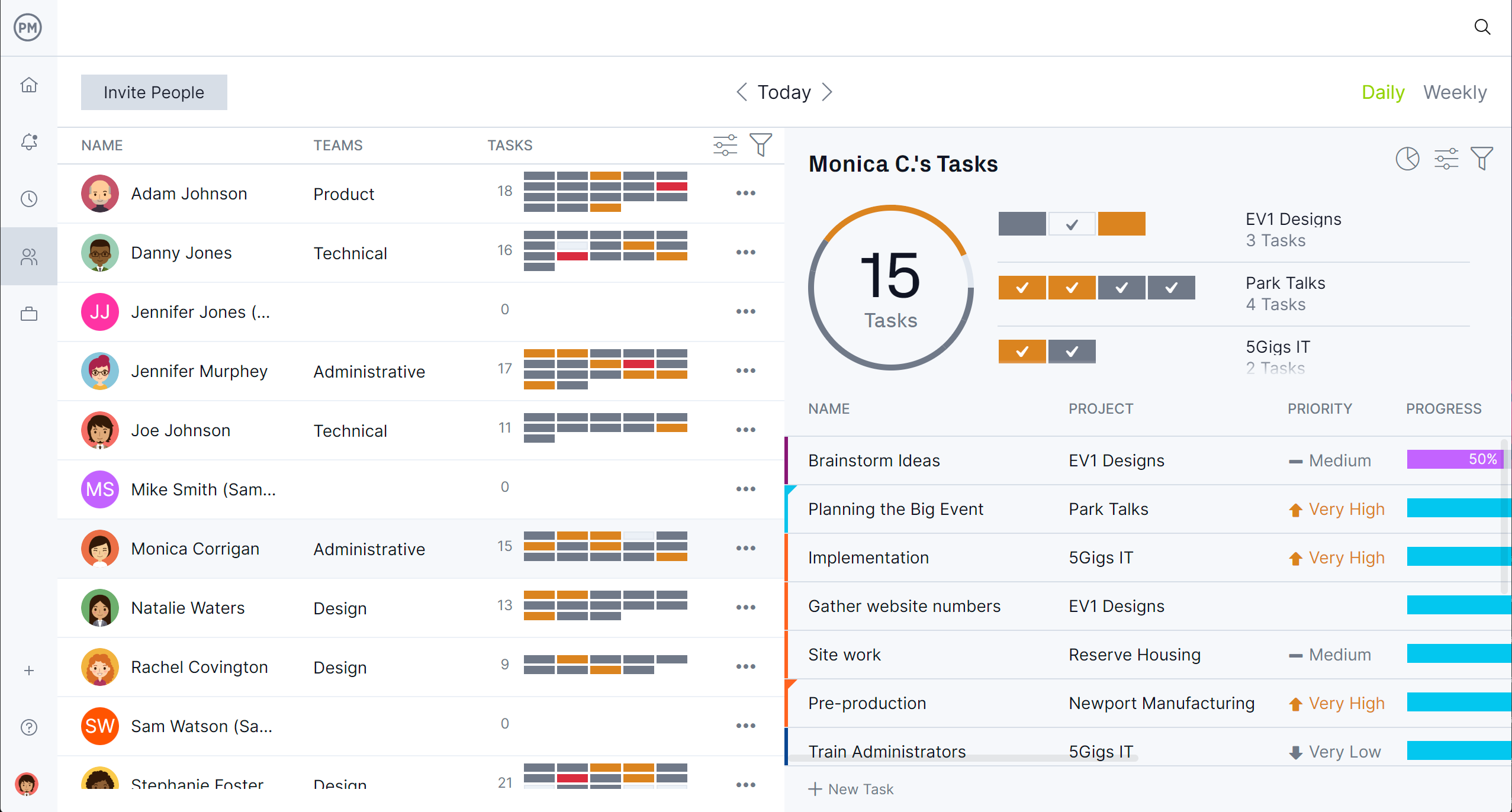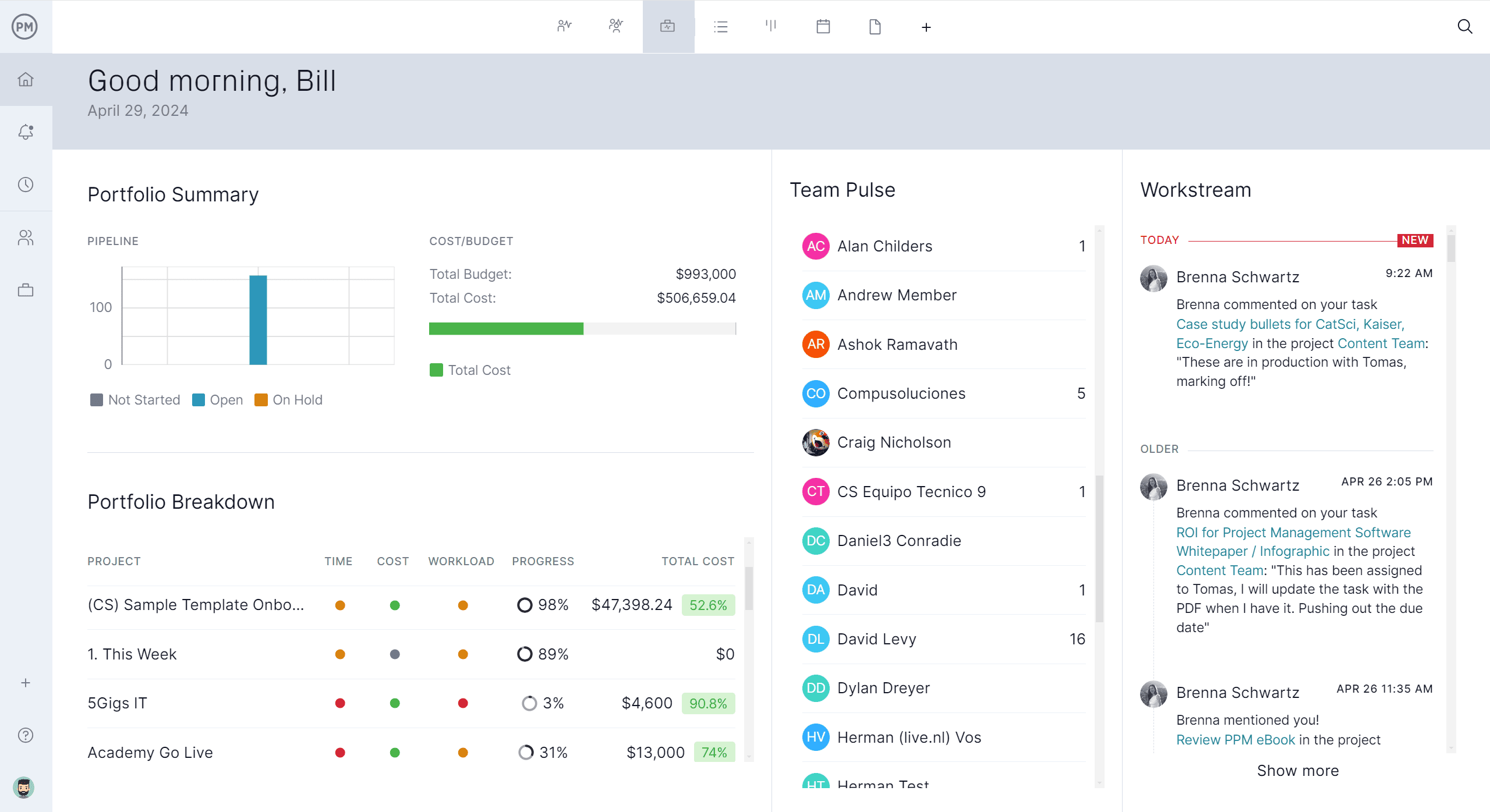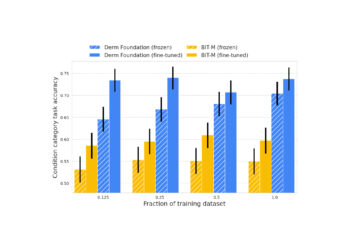Creating a portfolio management report is about turning project data into actionable insights that support strategic decision-making. It helps leadership understand how individual projects are performing within the broader portfolio and whether resources are being used effectively. The report should reflect current progress, highlight any risks or issues and provide clarity on how the overall portfolio supports business objectives.
To make the process efficient, it’s important to start with organized, up-to-date project information and choose the right tools to present it. Whether you’re reporting to executives, stakeholders or a PMO, the report should be structured, concise and focused on outcomes. With the right approach, your portfolio report becomes more than a status update—it becomes a decision-making tool that keeps strategy and execution aligned.
What Is a Portfolio Management Report?
A portfolio management report is a structured summary that provides visibility into how projects across the organization are performing in relation to those strategic goals and objectives. It tracks progress, resource use, timelines and risk, giving leadership the insights they need to assess whether the portfolio is delivering value. This report ensures that every initiative contributes to the organization’s broader mission and helps drive smarter prioritization and investment.
A portfolio management report helps to achieve the goals and objectives that define the strategic outcomes an organization aims to achieve through the collective execution of its projects and programs. Goals are high-level, long-term targets that reflect business priorities such as expanding market share, improving service delivery or increasing profitability. Objectives are more specific, measurable actions that support those goals—for example, launching a new product line within six months or cutting operational costs by a set percentage.
Project management software is more effective and efficient at creating portfolio management reports because it integrates project data into one system, automates reporting and updates key metrics in real time. This eliminates manual effort, reduces errors and enables faster, more strategic decision-making with up-to-date information.
ProjectManager is award-winning project and portfolio management software with a portfolio report that stands out by offering a live, comprehensive view of all projects aligned with strategic goals. It includes customizable dashboards, performance analytics and a high-level roadmap that shows how initiatives progress over time. This allows executives and PMOs to quickly assess project alignment, track resource utilization and make proactive decisions to keep the entire portfolio on course. Get started with ProjectManager today for free.


Why Is It Important to Make a Portfolio Management Report?
Creating a portfolio management report is essential for organizations that want to stay aligned with their strategic goals while managing multiple projects. It brings together key data from across the project portfolio and transforms it into a clear, concise view of progress, performance and resource utilization. With this visibility, leadership can assess whether initiatives are delivering expected value and make informed decisions about where to invest time, money and people.
A portfolio management report also supports better prioritization. Not all projects have equal impact, and a well-structured report helps identify which ones are most critical to long-term objectives. It enables leaders to compare project performance, flag risks early and reallocate resources when needed to maximize returns. Without this kind of insight, organizations risk spreading themselves too thin or continuing to fund low-value efforts.
Beyond internal efficiency, a portfolio management report also plays a key role in communication. It provides a unified view that keeps stakeholders, executives and teams aligned on priorities, timelines and outcomes. By creating a consistent reporting structure, organizations build trust and accountability—essential ingredients for maintaining momentum across large or complex portfolios.
Ultimately, a portfolio management report is more than just a document—it’s a strategic tool. When updated regularly and used effectively, it helps organizations stay focused, agile and aligned, ensuring that every project contributes meaningfully to the bigger picture.
Related: Best Project Portfolio Management Software
What Should Be Included in a Portfolio Management Report?
A well-structured portfolio management report gives decision-makers a clear, comprehensive view of how the entire project portfolio supports strategic business goals. It should include key insights across multiple performance areas—such as progress, risk, resources and financials—to help leaders make informed choices and maintain alignment with organizational priorities. Including the following components ensures your portfolio management report delivers value, clarity and actionable direction.
Portfolio Goals and Objectives
This section outlines the high-level goals and measurable objectives that each project within the portfolio is designed to support. It defines what the organization aims to achieve strategically and breaks that vision down into actionable outcomes that guide project selection and prioritization.
These goals and objectives provide a reference point for evaluating project performance and value, ensuring that every initiative contributes to the overall direction of the business. By including this section in the portfolio management report, stakeholders can see how the portfolio drives long-term success and operational focus.
Strategic Alignment Summary
This summary shows how each active project aligns with broader business strategies and organizational priorities. It helps validate that time, money and resources are being invested in the right initiatives and reinforces the connection between project execution and enterprise-wide goals.
This alignment check ensures that all efforts are coordinated and reduces the risk of pursuing work that doesn’t advance the company’s mission. Including a strategic alignment summary in the portfolio management report builds confidence among stakeholders and helps maintain consistency across departments and business units.
Financial Overview
A financial overview presents budgeted versus actual costs across the portfolio and offers critical insight into financial health. It may include total project spend, cost variance and forecasts to completion, giving executives the tools to make informed funding and allocation decisions.
This section also helps identify cost overruns or areas where savings may be possible, allowing for early corrective action. By featuring financial data in the portfolio management report, organizations can manage risk, protect margins and ensure that the portfolio remains sustainable and strategically viable.
Benefits Realization
This section of the portfolio management report tracks both the tangible and intangible benefits delivered by projects and programs over time. These benefits may include increased revenue, enhanced customer satisfaction, improved internal processes or long-term growth potential.
Tracking this information helps verify that completed projects have fulfilled their intended value and supports ongoing business justification for in-flight initiatives. Benefits realization also plays a critical role in refining future portfolio strategies by showing which types of projects yield the highest returns.
Resource Utilization and Capacity Planning
This portion of the portfolio management report provides detailed insight into how people, teams and departments are allocated across active and upcoming projects. It highlights where resources are being overused, underused or strained beyond capacity, allowing managers to rebalance workloads and prevent burnout.
Capacity planning data helps forecast future staffing needs and ensures that key resources are available for priority initiatives. This section is essential for long-term planning, talent management and ensuring that strategic goals are achievable with the available workforce.
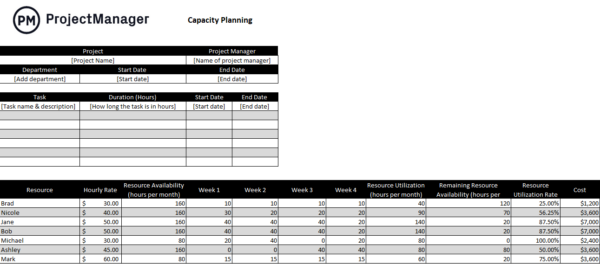

Project Progress Reports
Progress reports give an overview of current task completion, upcoming milestones and whether projects are on track according to their planned timelines. This section provides a quick snapshot of how work is advancing across the portfolio and where attention may be needed.
It enables stakeholders to spot lagging projects early and evaluate whether deliverables are being met as scheduled. Including progress reports in the portfolio management report fosters accountability and keeps the leadership team informed and engaged.
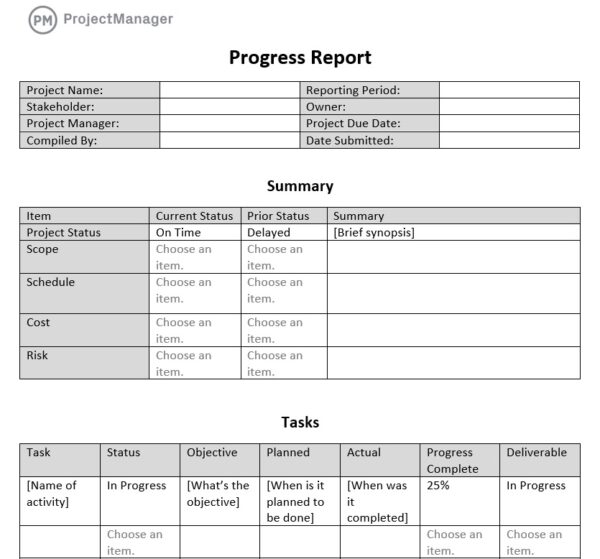

Project Status Reports
Status reports go beyond general progress to include current project health indicators, risks, issues and blockers. These updates help identify whether projects are within scope, budget and time constraints, or if they are experiencing setbacks that require escalation. They may also include color-coded health statuses or executive summaries for quick reference. This section strengthens the portfolio management report by enabling faster decision-making and supporting more agile responses to emerging challenges.
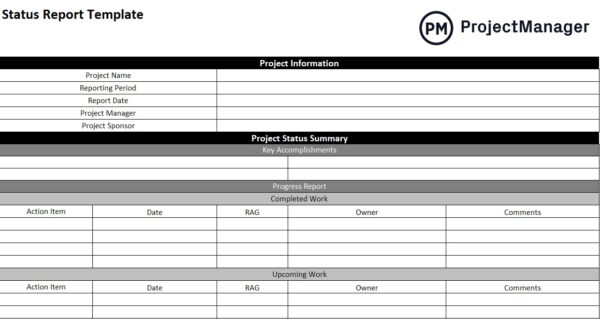

Interdependencies Between Projects and Programs
This section maps and explains how projects influence or rely on each other within the portfolio. It includes critical links such as shared resources, outputs that feed into other initiatives or timing dependencies that affect sequencing. Understanding these relationships helps project managers and portfolio leaders avoid scheduling conflicts, manage overlapping risks and plan project timelines with greater accuracy. By addressing interdependencies in the portfolio management report, organizations can coordinate better and improve cross-project communication.
Portfolio-Level RAID Log
A RAID (Risks, Assumptions, Issues, Dependencies) log at the portfolio level consolidates high-impact concerns that span multiple projects. This centralized view helps leadership monitor potential threats, validate assumptions and manage interrelated risks that could disrupt delivery. It ensures that risk mitigation is proactive rather than reactive and that interdependencies are tracked systematically. Including a RAID log in the portfolio management report supports comprehensive risk governance and improves overall portfolio resilience.
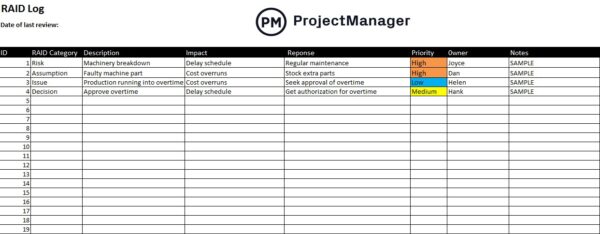

Change Management Log
This log captures and records any approved changes to project scope, budgets, resources or delivery timelines. It tracks who authorized the changes, why the changes were made and how they impact the rest of the portfolio. This level of documentation supports transparency and ensures accountability for decisions that may alter project trajectories. Including a change management log in the portfolio management report helps maintain clarity, reduce scope creep and preserve alignment with original strategic goals.


ProjectManager Is Ideal for Managing Project Portfolios
ProjectManager manages more than a portfolio management report. It’s a full portfolio management software offering multiple project views that give teams and executives flexibility without sacrificing visibility. Whether you’re using Gantt charts to plan timelines, kanban boards to manage workflows or task lists for daily priorities, all views are synced to a central data source.
The roadmap view provides a high-level timeline of all projects across the portfolio, helping portfolio managers visualize how initiatives align with strategic goals and where milestones or overlaps occur. This makes it easier to balance priorities, sequence projects effectively and ensure everything stays aligned with broader business objectives.
Manage Resources Across Projects
Our resource management is built for portfolio-level planning. The software includes features like workload tracking, availability forecasting and a team page that shows how team members are allocated across all active projects. These tools help managers identify over-allocations, adjust workloads in real time and avoid burnout.
By offering a centralized view of who is doing what and when, our software balances workload and views all team member activity across projects to ensure resources are used efficiently and aligned with the most critical initiatives, making it easier to meet deadlines and stay on budget across the portfolio.
Track Portfolio Metrics in Real Time
For monitoring and control, use real-time dashboards, live progress tracking and built-in reports. Dashboards provide instant updates on KPIs like task completion, time logged and budget usage across the portfolio. You can drill down into specific projects to see status, risks and delays, or view overall portfolio health at a glance.
Automated reports and customizable alerts keep stakeholders informed without the need for manual updates. These tracking features help portfolio managers stay proactive, quickly identify underperforming projects and make data-driven adjustments to keep everything on track.
Related Project Portfolio Management Content
A portfolio management report is only one piece of the larger project portfolio management process. For those interested in reading more about this subject, below are several recent articles we’ve published ranking different software solutions, listing free templates and more.
ProjectManager is online project and portfolio management software that connects teams whether they’re in the office or out in the field. They can share files, comment at the task level and stay updated with email and in-app notifications. Join teams at Avis, Nestle and Siemens who are using our software to deliver successful projects. Get started with ProjectManager today for free.
